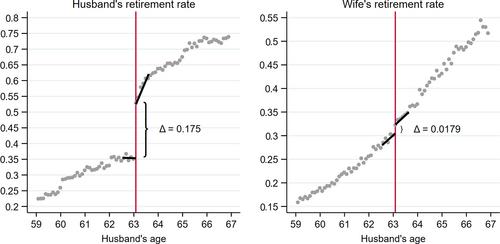按家庭类型划分的夫妻共同退休:来自芬兰的证据
IF 0.7
Q4 INDUSTRIAL RELATIONS & LABOR
引用次数: 0
摘要
本研究考察了芬兰的共同退休制度。采用回归不连续设计,研究利用外生变量提供的资格年龄与收入相关的养老金。分析得出了三个关键发现。首先,达到资格年龄对个人的退休有重大影响。第二,男性配偶在63岁退休对其女性配偶有溢出效应。第三,分类分析表明,低收入家庭中年龄较大的配偶推迟退休,女性(男性)主要收入者的年龄较大的男(女)配偶推迟退休,男性主要收入者的年龄较小的女性配偶加快退休。本文章由计算机程序翻译,如有差异,请以英文原文为准。

Couples' joint retirement by household type: Evidence from Finland
This study examines joint retirement in Finland. Employing a regression discontinuity design, the study leverages the exogenous variation provided by the eligibility age for earnings-related pensions. The analysis yields three key findings. First, reaching the eligibility age has a significant effect on an individual's retirement. Second, male spouses' retirement at the age of 63 has a spillover effect on their female spouses. Third, disaggregated analyses show that older spouses in low-income households delay their retirement, older male (female) spouses with female (male) primary earners postpone their retirement, and younger female spouses with male primary earners expedite their retirement.
求助全文
通过发布文献求助,成功后即可免费获取论文全文。
去求助
来源期刊

Labour-England
INDUSTRIAL RELATIONS & LABOR-
CiteScore
1.30
自引率
16.70%
发文量
25
期刊介绍:
LABOUR provides a forum for analysis and debate on issues concerning labour economics and industrial relations. The Journal publishes high quality contributions which combine economic theory and statistical methodology in order to analyse behaviour, institutions and policies relevant to the labour market.
 求助内容:
求助内容: 应助结果提醒方式:
应助结果提醒方式:


